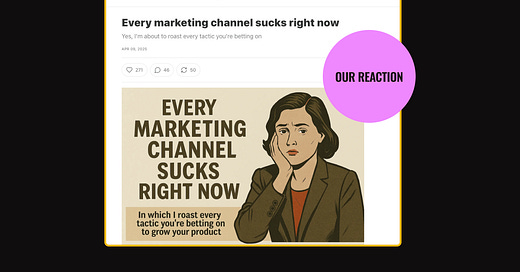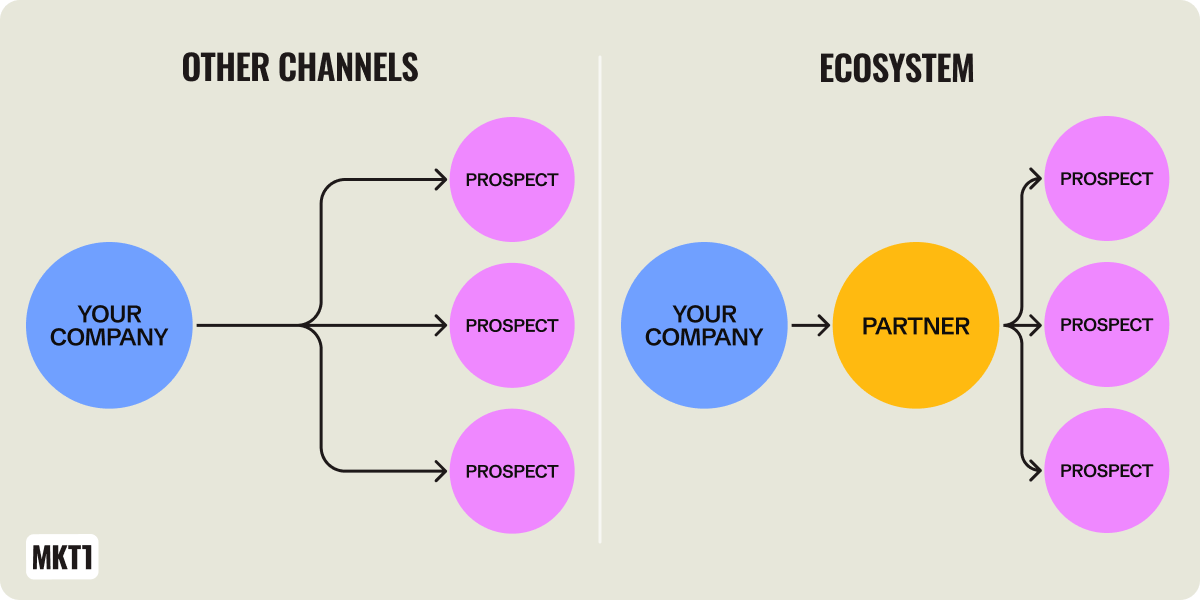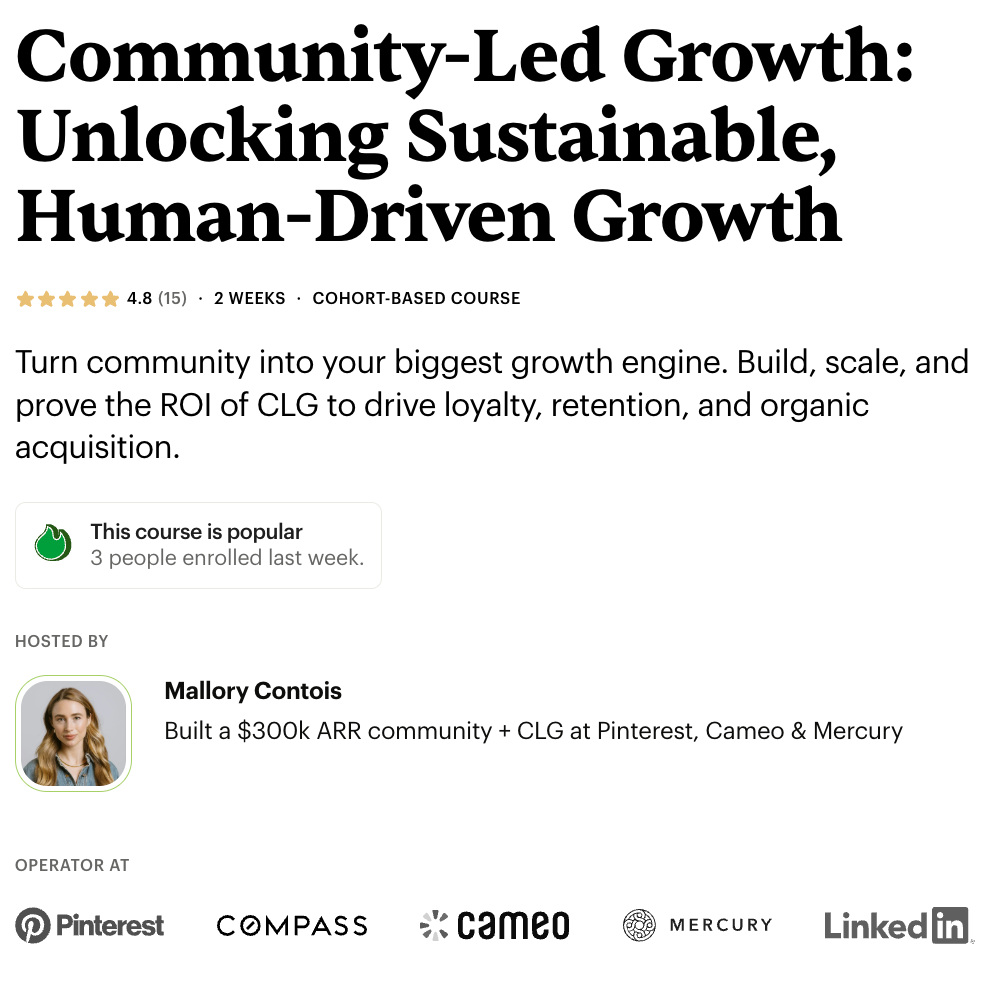Does every marketing channel *actually* suck right now?
A reaction to Andrew Chen's Substack post: "Every marketing channel sucks right now"
👋 This is an unplanned, bonus edition of MKT1 Newsletter. The free edition is a summary of a conversation and the paid subscriber edition features the full 30-minute conversation between me and community-marketing expert Mallory Contois.
I read a LinkedIn post and an article last week that bummed me out. Andrew Chen’s Substack, “Every marketing channel sucks right now,” as the title suggests, isn’t exactly a hopeful take on the state of marketing. It paints a bleak picture of marketing in 2025—and I only agree with ~33% of it.
No disrespect to Andrew (everyone’s entitled to a POV), but I wanted to offer a more solutions-focused and nuanced response, not just a list of everything that’s broken.
I noticed my friend Mallory Contois, Head of Community at Mercury and founder of Old Girls Club community, also commented on Andrew’s LinkedIn post. So we hit record and chatted all about the article on Friday.
This article and video are for anyone who felt a little bummed out reading the article, and is ready to get fired up again.
Note: Since we recorded, Andrew updated his post with a more positive outlook and a more tactical roadmap for early-stage founders. Our critiques still stand, but we’re glad to see more nuance in the newer version. I’ve pointed out if quotes are from the original or new version!
In this newsletter…
This newsletter recaps my conversation with Mallory and our take on marketing right now. We’ve both been in marketing long enough to know that yes, things are changing, but we think it’s a really exciting time to be a marketer.
🔍 Channel-by-channel breakdown: Andrew’s critiques vs. my take on what’s still working (and what’s not)
👑 Is product king?: It’s not product or marketing—it’s both
🏀 The one-channel myth: Real GTM requires star players, but also a full-team of channels
📉 Are big channels dead?: The channels that “work” are changing and emerging channels are worth focusing on
🌱 Can “little channels” scale?: New tools are making even the “little channels” scalable
🤝 Ecosystem marketing = the next big channel: Try human, creative, trust-driven “channels”
🎨 Art > algorithm: AI made marketing faster, more generic, and commoditized. Now differentiation matters more than ever
Paid subscribers can access the full video of our conversation at the bottom of the newsletter.
This post doesn’t have sponsors, it was that off the cuff, but I do recommend Mallory’s course on Maven ”Community-Led Growth: Unlocking Sustainable, Human-Driven Growth” And you can get $100 off using that link.
Quick note: Andrew mentions this is mostly focused on early-stage startups. Our advice is geared toward early-stage and growth-stage startups in B2B.
Channel by channel state of the world
Andrew kicked off his article with his gripes on each “big channel.” I thought I’d give my impressions based on all my work with marketers as an advisor and investor (and as a marketing-obsessed creator).
Here’s a summary of what Andrew said in his original post:
SEO: Slow, crowded
Influencer marketing: Expensive, small creators require hand-holding
PR/comms: Doesn’t drive signups, not repeatable
Email marketing: Hard to build a good list, spam filters everywhere
Viral loops: Only work with a great product, outdated hacks don’t work
Ads: Expensive, investors hate it unless your unit economics are perfect
Referral/affiliate: High fraud risk, often just as costly as paid
Big launch on social: Algorithm fights you, friends get tired of boosting your stuff
Here’s my take on each channel Andrew mentions:
SEO: Saturated, but it’s still worth covering the basics and ranking for high-intent keywords. Just don’t waste cycles producing generic how-to content that’s better answered by zero-click LLM summaries.
Influencer marketing: Becoming more scalable by the day. The handholding can be worth it if you work with the right influencers.
PR/comms: Traditional publications have been suffering for a while and there simply aren’t enough tech journalists to cover all the news they used to cover. Influencer marketing can help fill the gaps here
Email marketing: Email deliverability is a huge struggle, but building lists of accounts and contacts and using intent signals to target the right people at the right time is easier than ever with enrichment tools (when used correctly).
Viral loops: I don’t think much has changed here. I see AI products and trends go “viral” all the time—just think about all those AI-generated action figure images on LinkedIn last week.
Ads: Should have always been part of your strategy, not the only strategy. Targeting the right people is easier, you just need to break through the noise on content.
Referral/affiliate: If you have something of value to share and offer, this can work. You have to nail the incentives and this may look different today than it did in the Dropbox era.
Social: Social algorithms are mysterious, brand accounts have a harder time gaining traction these. But if invest early in growing personal accounts or work with established influencers it can work well.
Our reaction to the full article
Now I’ll break down Andrew’s key points and our responses—what we agreed with, what we disagreed with, and why we think this is actually marketing’s moment to shine.
1. Is product king?
Product is (unfortunately) King
So I have bad news: Your product actually has to be very good. I wish I lived in a world where you could have amazing marketing and growth strategies, have a shitty product, and you would win. Then marketers would run tech, and they do not. It’s the people visionaries that create the products that run tech, and that’s a good thing!
-Andrew Chen
Our take: You need a differentiated product + differentiated marketing to win
It’s simply not one or the other. It’s become too easy to build product and too easy to build marketing content for this not to be the case.
We reject the framing that marketers aren’t visionaries or builders. Great marketers are just as strategic and market-defining as product leaders. They understand the market, your audience, your product and how to reach the right people at the right time. And your brand and content is another product after all.
Also, I think it would be a pretty good thing if no one “ran” tech. And instead, we all were respected and valued as contributors, even us marketers :)
Video highlights:
“Marketers when they’re great are like product people. They’re visionary. They understand the market. They’re building products themselves.” – Kramer
“The ideal world is a beautiful partnership between product, design, engineering, marketing, and sales.” – Mallory
“Anything that is different is going to be inherently harder.” - Mallory
Apologies that the audio and video quality isn’t top notch here, this was a last minute convo we decided to record and my mic wasn’t cooperating!
2. One channel to rule them all?
“Many startups are built on a single channel — like SEO, paid ads, or some viral loop — and then eventually stall when it stops working. Then, boom, it’s flatlined.”
“There are few channels that can sustainably grow a startup into a huge business. Instead, most channels just tap out. They grow you to a certain level, and then the channel gets saturated, or the CAC gets too high.”
-Andrew Chen, in his original post, it has since been edited from it’s original version
Our take: It’s never been one channel, really
The idea that one channel—like SEO, paid ads, or virality—can single-handedly build a business is a popular myth, especially in VC and founder storytelling.
I advocate for making big bets on high-impact initiatives and concentrating efforts when you know what’s working—but that’s not the whole story. Even the most impactful channel needs support from a broader system. When teams over-attribute growth to a single lever, they risk ignoring the orchestration and adaptability that actually make modern GTM work.
This has always been the case, IMO. Is this more true now? I don’t think it matters. You need to place big bets, test new things, stay nimble, and never get too comfortable, or risk losing. This goes for both marketing and product.
Directly from our conversation:
“Steph Curry on the Warriors couldn’t win games without the rest of his team.” – Emily (timely reference if you’re into the NBA, I know)
“A lot of times, like you said, there’s a star channel, but there is a baseline requirement across other channels to make the funnel actually work.” – Mallory
2. Big channels are saturated—but it’s not end times?
“Unfortunately this is the state of growth marketing. A lot of channels are not working, or are slow, expensive, or one-time only. This is the natural end state for things, and maybe we’re in a bit of a lull due to the technology super cycle as we’re 15+ years into the mobile wave, we’ve had various kinds of paid ads for 20+ years, and so on. All of these aforementioned marketing channels are now fully mature.”
-Andrew Chen
Our take: It’s not “end” times for marketing
As long as people need to buy things, services, products, “agents,” etc. some form of marketing will exist. Marketing means telling humans about these things. And if these channels were truly dead, Andrew’s newsletter and social post themselves would have been seen by no one.
That’s a bit meta, but I don’t think it’s as dramatic as this picture paints. Things always cycle in and out. Yes, you have to get creative, yes it’s a new era. But the first principles of marketing haven’t changed.
Yes, many big channels are harder—but that doesn’t mean they’re dead.
Smaller teams and leaner headcount are making it harder to execute across all channels, not just use them—hey VCs & founders, maybe we need to hire more marketers to make marketing come “alive” again?
Inbound is changing, especially search, but this started before LLMs. It started in the ZIRP era, but that’s a whole other post.
Directly from our conversation:
“Teams being shrunk down…is making it seem like nothing’s working. ‘Cause there just aren’t enough humans to do the multifaceted, multifunctional, full-stack marketing stuff that needs to get done.” – Emily
“Marketing today really does…require an extra level of creativity, of personalization, of strategy, of human-centered understanding.” – Mallory
3. Build & scale through “little channels”?
“Don’t focus on Big Channels, focus on Little Channels: First, you should just know that all the aforementioned big, mature channels will suck for you. These channels have mostly all been bid up by bigger companies…what you can do that they can’t? The natural solution points towards Little Channels, which are all the smaller marketing strategies that are tried in the early days and abandoned over time.…But the Little Channels are often short-lived, which is why they haven’t already been scooped up by the big co’s. And so, you’ll have to churn through a lot of them.”
-Andrew Chen, in his original post, it has since been edited from it’s original version
Our take: “Little channels” can scale now due to modern tools
I’m going to reframe this as “established” and “emerging” channels, rather than “big” and “little”. “Established” channels by definition are the go-tos, and are therefore saturated. “Emerging” channels are less popular and present more opportunity.
So yes, lean into those channels.
But I disagree that these channels don’t scale. Many of the emerging channels, like community, partnerships, influencers, and intimate events, are becoming more scalable by the day. Platforms are popping up to help manage all of them. Will they ever be as easy to run as AdWords? Probably not. But that’s the point. In an AI-saturated world, people are craving authenticity, and these channels deliver it.
There is one thing I really agree on in the quote above though: One of the best ways to win is to figure out what you can do as a startup that bigger companies can’t. Figure out what they would never do and if you believe it has legs, take that path. Again, this is very similar to how you build new products.
Directly from our conversation:
“These ‘unscalable’ channels are actually extremely scalable now—you just need creative human input.” – Mallory
“The little channels you test today are the big channels of tomorrow.” – Emily
“Ecosystem is the next big channel. It just doesn’t look like one.” – Emily
4. Ecosystem & community = the solution?
“You’ll probably also have to invest in small, emerging channels—what I call ‘Little Channels’—and be prepared to abandon them over time. That might be working with niche influencers, some new community product, doing edgy events, or investing in emerging content formats.”
– Andrew Chen in his original post, which has since been updated to say these may be able to scale (we agree!)
Our take: Look to other humans to help you grow
Ecosystem marketing as I define it means using third parties to grow by leveraging the reach, trust, and authority of creators, customers, partners, influencers, and communities.
Community marketing nests under ecosystem marketing in MKT1 framework-land. Mallory describes community marketing as high-trust, human-centered growth tactics that prioritize real relationships over automation-first playbooks.
But however you define it, we don’t just believe these ecosystem and community tactics work, we see it as the next big “channel.”
Companies like Clay are winning by going all-in on this strategy. It’s working because it’s human, creative, and built on relationships.
Directly from our conversation:
“We’re both excited about using communities and humans to grow your business and piggybacking on other people's reach and trust and authority.” – Emily
“Community-led growth isn’t just viable—it’s often the most effective strategy.” – Mallory
“The Steph Curry of Clay’s marketing strategy is their ecosystem play.” – Emily (I’ve never talked about sports this much)
5. Marketing: Harder now?
“This essay was not meant to be depressing, but rather to just call out the idea what we can all see—that most of the channels we work with are decades old, that the performance is teetering on an edge. Just as products are innovating by adopting new tech—AI, XR, web3, and so on—we in the marketing field need to innovate as well, by asking ourselves, where can I do something new with XYZ new tech?”
– Andrew Chen in both the original and current version of the article
Our take: New tech is driving is making the “art” of marketing more important (again)
I mostly agree with this takeaway. We need to keep innovating in marketing. But it’s not just about “doing something with XYZ new tech.”
AI has commoditized content, making it easier than ever to create but harder than ever to stand out. Everyone has access to the same enrichment data and signal data. Automation and agents are making it faster than ever to move faster in marketing. This is all rapidly becoming table stakes and a necessary foundation.
Counterintuitively, all this new tech and data means we’re (re)entering the art of marketing era. You won’t win by doing these things. In some ways, marketing is returning to its roots and we’re (re)entering the art of marketing era, where differentiation, human insight, and authenticity matter more than ever.
What breaks through now are spiky, creative, human ideas. But to really win, you have to do more than check the boxes. You have to stand out, and this part hasn’t changed.
Directly from our conversation:
“We’re entering the art of marketing era, not the algorithm of marketing era.” – Mallory
“The solution isn’t panic—it’s to differentiate. In your product, in your messaging, and in your execution.” – Emily
Warning: I get a little preachy and extra in this video and it’s 3 minutes, but it’s a good recap!
What to do next
It’s funny that this post is way longer than the original article. But all of these changes I think require a lot of nuance to understand and to figure out how to respond and move forward.
Here’s my recommendation:
I call this the MKT1 method, and I refer to it throughout all my newsletters (and yes it pains me that this article is in MKT1’s old design and I will fix it soon):
Understand your business, your audience, your market and your product
Choose the right high-level channels for your specific startup, no playbooks
Place strategic bets on high-impact work you can differentiate and do better than competitors. Avoid random acts of marketing!
Make sure you have a modern tech stack and foundation (hint: it’s account-driven)
Stay nimble
Don’t miss the full video of my conversation with Mallory at the bottom of this post for paid subscribers.
More from MKT1…
✂️ Templates & videos for paid subscribers: Available in our resources library for paid subscribers only
🎙️ Next podcast: Dear Marketers Episode 5 is out in mere days on driving sales & marketing alignment. Sorry for the delay on podcasts, I’ve been sick and taking a brief mid-season hiatus.
📰 Next newsletter: I’ll be writing about my own content strategy and lessons learned.
🧑🚀 Job board: Jobs from the MKT1 community.
Take Mallory’s course on Maven!
Learn how to turn community into your biggest growth engine. Sign up here to get 30% off: ”Community-Led Growth: Unlocking Sustainable, Human-Driven Growth”
Full video: Kramer & Mallory react to “Every channel sucks right now”
Below’s the full 30 min conversation we had last Friday. If you want to eavesdrop on our conversation, give it a watch. It’s available to paid subscribers.








